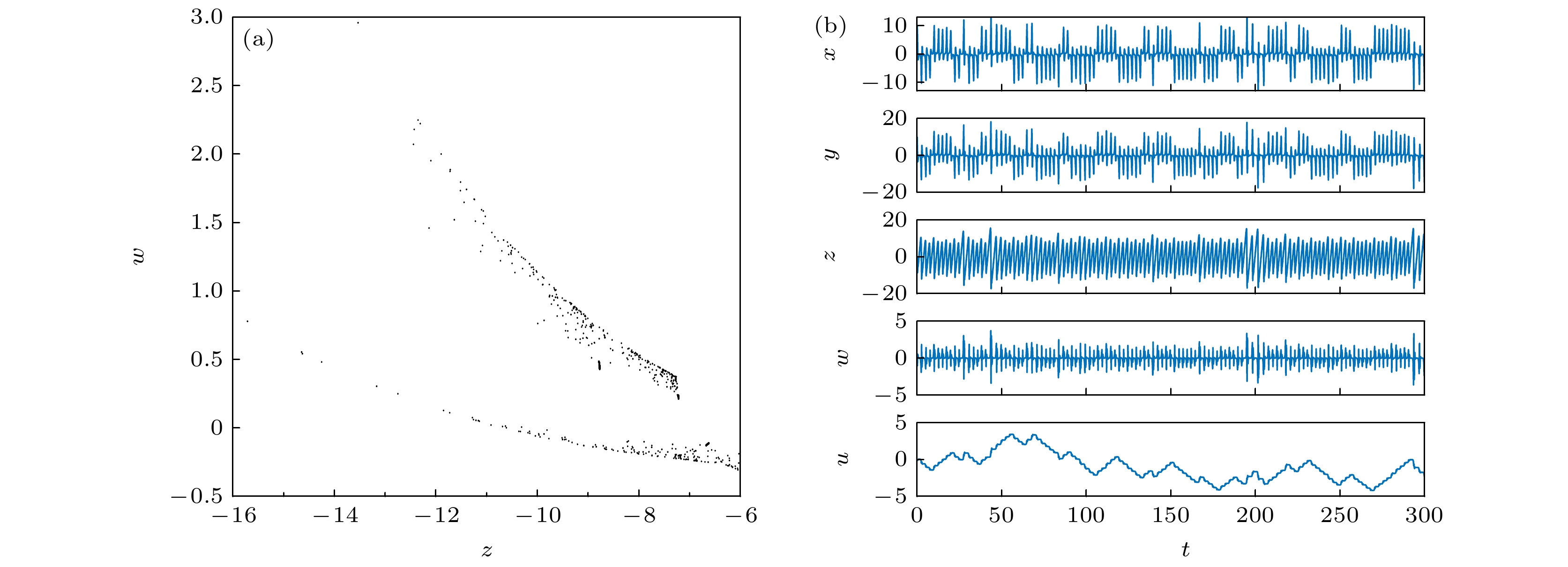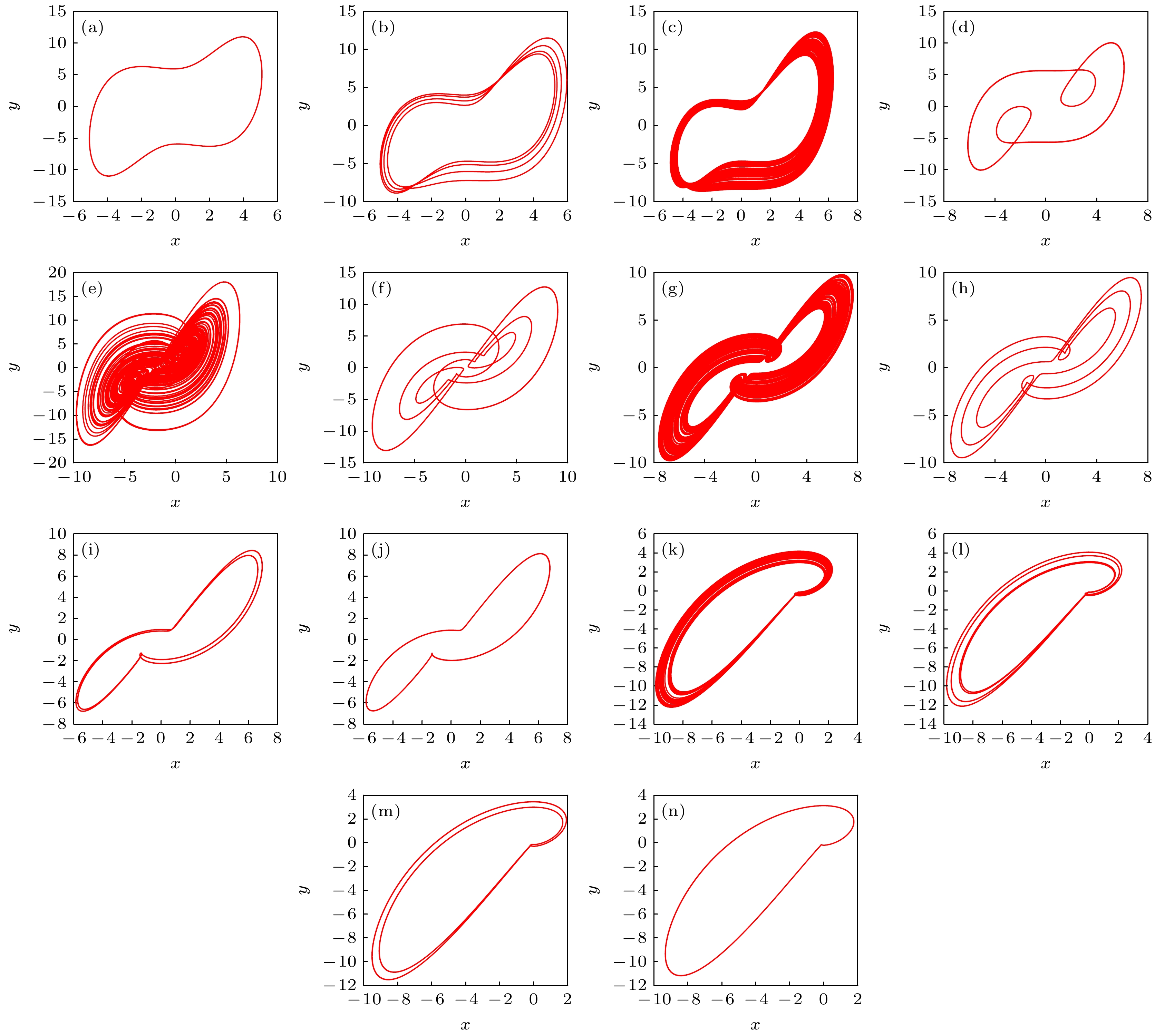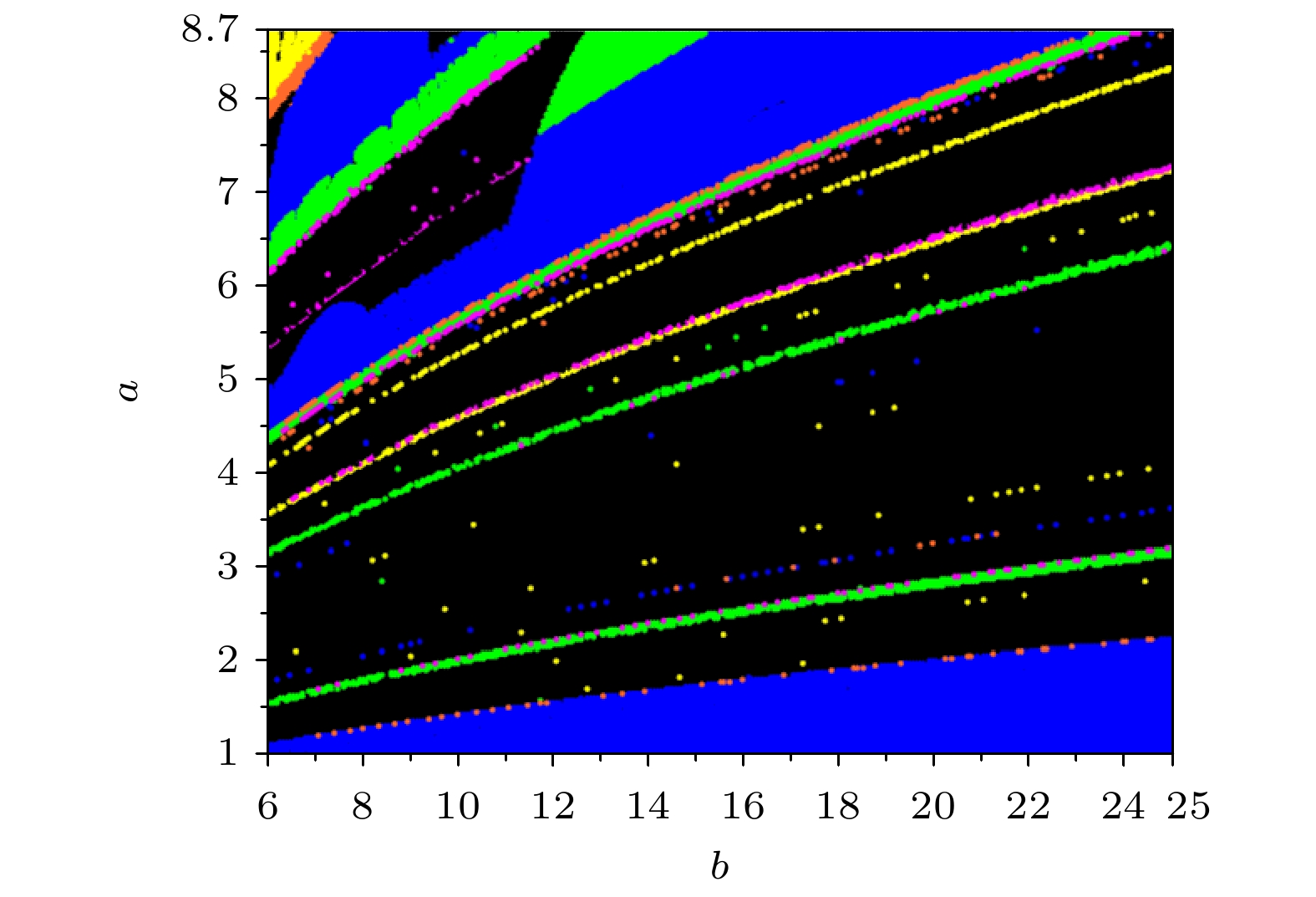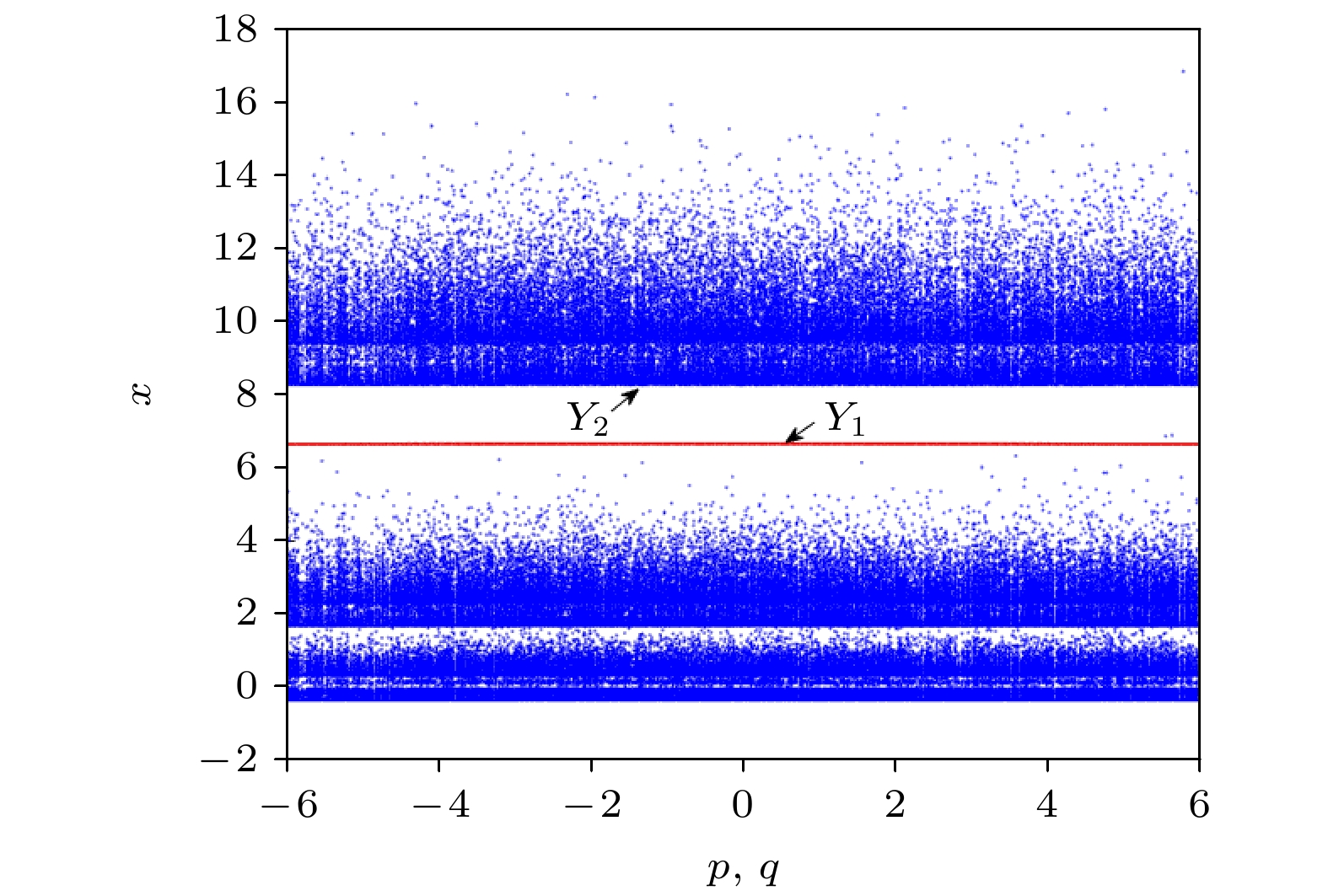-
The memristor is a kind of nonlinear element with nanometer size, which can enhance the complexity of a chaotic system. With the further research of chaos, several novel nonlinear phenomena have been found by scholars, such as hidden attractors, coexisting attractors and multi-stability. Meanwhile, the extremely multi-stability representation system coexists with the infinite attractors, which has become a hot spot in the field of memristor chaos research in recent years. A general method to construct a chaotic systems of multiple coexistence is to increase the number of equilibrium points of chaotic system by means of control. The introduction of memristor results in the linear distribution of the equilibrium points of chaotic system in space, which are the linear equilibrium points. The existing researches show that chaotic system with extremely multi-stability can produce better chaotic sequence, which can be used in engineering fields such as secure communication. Therefore, it is of great significance to construct chaotic systems with rich dynamic behaviors by using memristors. In order to further improve the complexity of the chaotic system, a five-dimensional memristor chaotic system is constructed by replacing the coupling parameters in the four-dimensional chaotic system based on Sprott-B with a magnetically controlled memristor. The dynamic behavior of the system is analyzed by bifurcation diagram, Lyapunov exponent spectrum, phase portrait, Poincaré map, dynamic map and other conventional means. The analysis shows that the new system has rich dynamic behaviors: when the system parameters change, the system can produce a large number of chaotic attractors with different topological structures and periodic limit cycles with different periods. When different parameters change, the dynamic characteristics of the system also change; when the system parameters are fixed, the system not only has an offset enhancement phenomenon that depends on the change of the initial conditions, but also shows a very strong sensitivity to the initial values and a great adjustment range of the initial values, which leads the infinite chaos and periodic attractors to coexist, namely extremely multi-stability appears. Finally, the digital circuit of the memristor chaotic system is implemented based on the field programmable gate array (FPGA) technology. The phase portrait captured on the oscilloscope is consistent with that from the numerical simulation, which verifies the correctness and realizability of the memristor system. -
Keywords:
- coexisting attractor /
- extremely multistability /
- field programmable gate array /
- memristive chaotic system
[1] Chua L O 1971 IEEE Trans. Circuits Theor. 18 507
 Google Scholar
Google Scholar
[2] Wen S P, Zeng Z G, Huang T W 2012 Phys. Lett. A 376 2775
 Google Scholar
Google Scholar
[3] Yang F F, Mou J, Sun K H, Cao Y H, Jin J Y 2019 IEEE Access 7 58751
 Google Scholar
Google Scholar
[4] 刘嵩, 韦亚萍, 刘静漪, 张国平 2020 华中师范大学学报(自然科学版) 54 36
 Google Scholar
Google Scholar
Liu S, Wei Y P, Liu J Y, Zhang G P 2020 J. Cent. Chin. Normal Univ. (Nat. Sci.) 54 36
 Google Scholar
Google Scholar
[5] Zhao L, Hong Q H, Wang X P 2018 Neurocomputing 314 207
 Google Scholar
Google Scholar
[6] Xu Q, Song Z, Bao H, Chen M, Bao B C 2018 Int. J. Electron. Commun. 96 66
 Google Scholar
Google Scholar
[7] Hong Q H, Zhao L, Wang X P 2019 Neurocomputing 330 11
 Google Scholar
Google Scholar
[8] Shin S, Kim K, Kang S M 2012 Electron. Lett. 48 78
 Google Scholar
Google Scholar
[9] Banerjee S, Parui S, Gupta A 2004 IEEE Trans. Circuits Syst. Ⅱ 51 649
 Google Scholar
Google Scholar
[10] Min X T, Wang X Y, Zhou P F, Yu S M, Lu H H 2019 IEEE Access 7 124641
 Google Scholar
Google Scholar
[11] Jin P P, Wang G Y, Lu H H, Fernando T 2017 IEEE Trans. Circuits Syst. Ⅱ 65 246
 Google Scholar
Google Scholar
[12] 洪庆辉, 曾以成, 李志军 2013 物理学报 62 230502
 Google Scholar
Google Scholar
Hong Q H, Zeng Y C, Li Z J 2013 Acta Phys. Sin. 62 230502
 Google Scholar
Google Scholar
[13] Feudel U 2008 Int. J. Bifurcation Chaos 18 1607
 Google Scholar
Google Scholar
[14] Bao B C, Bao H, Wang N, Chen M, Xu Q 2017 Chaos, Solitons Fractals 94 102
 Google Scholar
Google Scholar
[15] Xu Q, Lin Y, Bao B C, Chen M 2016 Chaos, Solitons Fractals 83 186
 Google Scholar
Google Scholar
[16] Bao B C, Jiang T, Xu Q, Chen M, Wu H G, Hu Y H 2016 Nonlinear Dyn. 86 1711
 Google Scholar
Google Scholar
[17] Bao B C, Jiang T, Wang G Y, Jin P P, Bao H, Chen M 2017 Nonlinear Dyn. 89 1157
 Google Scholar
Google Scholar
[18] 闵富红, 王珠林, 曹戈, 王恩荣 2018 电子学报 46 486
 Google Scholar
Google Scholar
Min F H, Wang Z L, Cao G, Wang E R 2018 Acta Electron. Sin. 46 486
 Google Scholar
Google Scholar
[19] 秦铭宏, 赖强, 吴永红 2022 物理学报 71 160502
 Google Scholar
Google Scholar
Qin M H, Lai Q, Wu Y H 2022 Acta Phys. Sin. 71 160502
 Google Scholar
Google Scholar
[20] Lai Q, Kuate P, Pei H, Fostin H 2020 Complexity 86 1711
 Google Scholar
Google Scholar
[21] Lai Q 2021 Int. J. Bifurcation Chaos 31 2150013
 Google Scholar
Google Scholar
[22] Li Q D, Zeng H Z, Yang X S 2014 Nonlinear Dyn. 77 255
 Google Scholar
Google Scholar
[23] 徐强, 杨晓云, 罗姣燕, 徐权 2019 华中师范大学学报(自然科学版) 53 38
 Google Scholar
Google Scholar
Xu Q, Yang X Y, Luo J Y, Xu Q 2019 J. Cent. Chin. Normal Univ. (Nat. Sci. ) 53 38
 Google Scholar
Google Scholar
[24] Huang L L, Yao W J, Xiang J H, Zhang Z F 2020 Complexity 2020 1
 Google Scholar
Google Scholar
[25] 包伯成, 胡文, 许建平, 刘中, 邹凌 2011 物理学报 60 120502
 Google Scholar
Google Scholar
Bao B C, Hu W, Xu J P, Liu Z, Zou L 2011 Acta Phys. Sin. 60 120502
 Google Scholar
Google Scholar
[26] Huang L L, Zhang Z F, Xiang J H, Wang S M 2019 Complexity 2019 1
 Google Scholar
Google Scholar
[27] Wolf A, Swift J B, Swinney H L, Vastano J A 1985 Physica D 16 285
 Google Scholar
Google Scholar
-
表 1 不同系统参数
$ a $ 值对应的吸引子类别及编号Table 1. Attractor types and number corresponding to different values of system with parameter
$ a $ . -
[1] Chua L O 1971 IEEE Trans. Circuits Theor. 18 507
 Google Scholar
Google Scholar
[2] Wen S P, Zeng Z G, Huang T W 2012 Phys. Lett. A 376 2775
 Google Scholar
Google Scholar
[3] Yang F F, Mou J, Sun K H, Cao Y H, Jin J Y 2019 IEEE Access 7 58751
 Google Scholar
Google Scholar
[4] 刘嵩, 韦亚萍, 刘静漪, 张国平 2020 华中师范大学学报(自然科学版) 54 36
 Google Scholar
Google Scholar
Liu S, Wei Y P, Liu J Y, Zhang G P 2020 J. Cent. Chin. Normal Univ. (Nat. Sci.) 54 36
 Google Scholar
Google Scholar
[5] Zhao L, Hong Q H, Wang X P 2018 Neurocomputing 314 207
 Google Scholar
Google Scholar
[6] Xu Q, Song Z, Bao H, Chen M, Bao B C 2018 Int. J. Electron. Commun. 96 66
 Google Scholar
Google Scholar
[7] Hong Q H, Zhao L, Wang X P 2019 Neurocomputing 330 11
 Google Scholar
Google Scholar
[8] Shin S, Kim K, Kang S M 2012 Electron. Lett. 48 78
 Google Scholar
Google Scholar
[9] Banerjee S, Parui S, Gupta A 2004 IEEE Trans. Circuits Syst. Ⅱ 51 649
 Google Scholar
Google Scholar
[10] Min X T, Wang X Y, Zhou P F, Yu S M, Lu H H 2019 IEEE Access 7 124641
 Google Scholar
Google Scholar
[11] Jin P P, Wang G Y, Lu H H, Fernando T 2017 IEEE Trans. Circuits Syst. Ⅱ 65 246
 Google Scholar
Google Scholar
[12] 洪庆辉, 曾以成, 李志军 2013 物理学报 62 230502
 Google Scholar
Google Scholar
Hong Q H, Zeng Y C, Li Z J 2013 Acta Phys. Sin. 62 230502
 Google Scholar
Google Scholar
[13] Feudel U 2008 Int. J. Bifurcation Chaos 18 1607
 Google Scholar
Google Scholar
[14] Bao B C, Bao H, Wang N, Chen M, Xu Q 2017 Chaos, Solitons Fractals 94 102
 Google Scholar
Google Scholar
[15] Xu Q, Lin Y, Bao B C, Chen M 2016 Chaos, Solitons Fractals 83 186
 Google Scholar
Google Scholar
[16] Bao B C, Jiang T, Xu Q, Chen M, Wu H G, Hu Y H 2016 Nonlinear Dyn. 86 1711
 Google Scholar
Google Scholar
[17] Bao B C, Jiang T, Wang G Y, Jin P P, Bao H, Chen M 2017 Nonlinear Dyn. 89 1157
 Google Scholar
Google Scholar
[18] 闵富红, 王珠林, 曹戈, 王恩荣 2018 电子学报 46 486
 Google Scholar
Google Scholar
Min F H, Wang Z L, Cao G, Wang E R 2018 Acta Electron. Sin. 46 486
 Google Scholar
Google Scholar
[19] 秦铭宏, 赖强, 吴永红 2022 物理学报 71 160502
 Google Scholar
Google Scholar
Qin M H, Lai Q, Wu Y H 2022 Acta Phys. Sin. 71 160502
 Google Scholar
Google Scholar
[20] Lai Q, Kuate P, Pei H, Fostin H 2020 Complexity 86 1711
 Google Scholar
Google Scholar
[21] Lai Q 2021 Int. J. Bifurcation Chaos 31 2150013
 Google Scholar
Google Scholar
[22] Li Q D, Zeng H Z, Yang X S 2014 Nonlinear Dyn. 77 255
 Google Scholar
Google Scholar
[23] 徐强, 杨晓云, 罗姣燕, 徐权 2019 华中师范大学学报(自然科学版) 53 38
 Google Scholar
Google Scholar
Xu Q, Yang X Y, Luo J Y, Xu Q 2019 J. Cent. Chin. Normal Univ. (Nat. Sci. ) 53 38
 Google Scholar
Google Scholar
[24] Huang L L, Yao W J, Xiang J H, Zhang Z F 2020 Complexity 2020 1
 Google Scholar
Google Scholar
[25] 包伯成, 胡文, 许建平, 刘中, 邹凌 2011 物理学报 60 120502
 Google Scholar
Google Scholar
Bao B C, Hu W, Xu J P, Liu Z, Zou L 2011 Acta Phys. Sin. 60 120502
 Google Scholar
Google Scholar
[26] Huang L L, Zhang Z F, Xiang J H, Wang S M 2019 Complexity 2019 1
 Google Scholar
Google Scholar
[27] Wolf A, Swift J B, Swinney H L, Vastano J A 1985 Physica D 16 285
 Google Scholar
Google Scholar
Catalog
Metrics
- Abstract views: 8912
- PDF Downloads: 178
- Cited By: 0














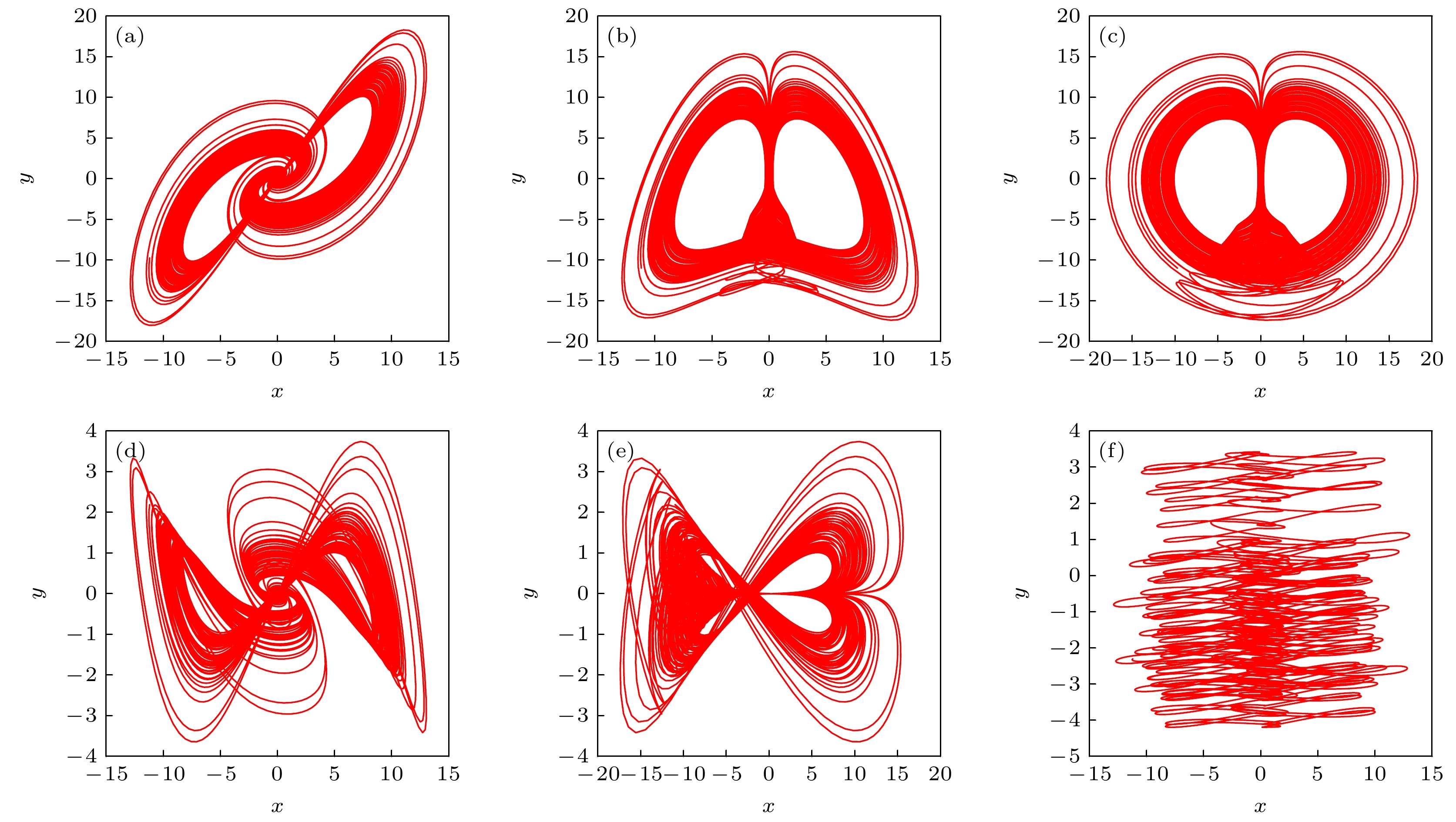
 DownLoad:
DownLoad:
